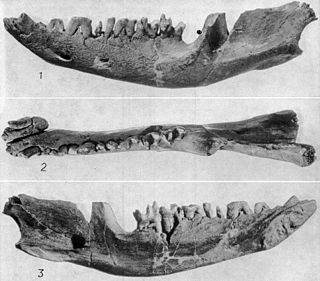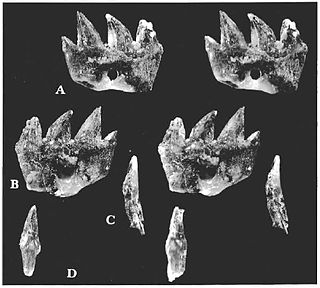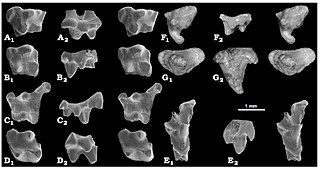
Multituberculata is an extinct order of rodent-like mammals with a fossil record spanning over 130 million years. They first appeared in the Middle Jurassic, and reached a peak diversity during the Late Cretaceous and Paleocene. They eventually declined from the mid Paleocene onwards, disappearing from the known fossil record in the late Eocene. They are the most diverse order of Mesozoic mammals with more than 200 species known, ranging from mouse-sized to beaver-sized. These species occupied a diversity of ecological niches, ranging from burrow-dwelling to squirrel-like arborealism to jerboa-like hoppers. Multituberculates are usually placed as crown mammals outside either of the two main groups of living mammals—Theria, including placentals and marsupials, and Monotremata—but usually as closer to Theria than to monotremes. They are considered to be closely related to Euharamiyida and Gondwanatheria as part of Allotheria.

Metatheria is a mammalian clade that includes all mammals more closely related to marsupials than to placentals. First proposed by Thomas Henry Huxley in 1880, it is a more inclusive group than the marsupials; it contains all marsupials as well as many extinct non-marsupial relatives.

Didelphodon is a genus of stagodont metatherians from the Late Cretaceous of North America.

Repenomamus is a genus of opossum- to badger-sized gobiconodontid mammal containing two species, Repenomamus robustus and Repenomamus giganticus. Both species are known from fossils found in China that date to the early Cretaceous period, about 125-123.2 million years ago. R. robustus is one of several Mesozoic mammals for which there is good evidence that it fed on vertebrates, including dinosaurs, though it is not possible to determine if it actively hunted live dinosaurs or scavenged dead ones. R. giganticus is among the largest mammals known from the Mesozoic era.

Eodelphis, from eo- plus [Di]delphis, thus meaning "very early opossum", is a genus of stagodont metatherians from the Late Cretaceous of North America, with distinctive crushing dentition. Named species include E. browni and the more advanced E. cutleri. Both come from the Late Campanian of Dinosaur Provincial Park, Alberta. Specimens are also known from the Judith River Formation of Montana. E. cutleri is related to the Maastrichtian genus Didelphodon as indicated by its enlarged premolars and more robust jaw. Eodelphis was probably an aquatic predator like its relative Didelphodon, and may have weighed about 0.6 kg (1.3 lb), making it one of the largest mammals of its time.

Pucadelphys is an extinct genus of non-marsupial metatherian. The genus contains a single species, P. andinus. Fossils of Pucadelphys have been found in the Santa Lucía Formation in Tiupampa in Bolivia.

Sparassodonta is an extinct order of carnivorous metatherian mammals native to South America, related to modern marsupials. They were once considered to be true marsupials, but are now thought to be a separate side branch that split before the last common ancestor of all modern marsupials. A number of these mammalian predators closely resemble placental predators that evolved separately on other continents, and are cited frequently as examples of convergent evolution. They were first described by Florentino Ameghino, from fossils found in the Santa Cruz beds of Patagonia. Sparassodonts were present throughout South America's long period of "splendid isolation" during the Cenozoic; during this time, they shared the niches for large warm-blooded predators with the flightless terror birds. Previously, it was thought that these mammals died out in the face of competition from "more competitive" placental carnivorans during the Pliocene Great American Interchange, but more recent research has showed that sparassodonts died out long before eutherian carnivores arrived in South America. Sparassodonts have been referred to as borhyaenoids by some authors, but currently the term Borhyaenoidea refers to a restricted subgroup of sparassodonts comprising borhyaenids and their close relatives.
Deltatheroida is an extinct group of basal metatherians that were distantly related to modern marsupials. The majority of known members of the group lived in the Cretaceous; one species, Gurbanodelta kara, is known from the late Paleocene (Gashatan) of China. Their fossils are restricted to Central Asia and North America. This order can be defined as all metatherians closer to Deltatheridium than to Marsupialia.

Stagodontidae is an extinct family of carnivorous metatherian mammals that inhabited North America and Europe during the late Cretaceous, and possibly to the Eocene in South America.

Pappotherium is an extinct genus of mammals from the Albian of Texas, US, known from a fossilized maxilla fragment bearing two tribosphenic molars, discovered within the Glen Rose Formation near Decatur, Wise County, Texas.
Siamoperadectes is a genus of non-marsupial metatherian from the Miocene of Thailand. A member of Peradectidae, it is the first member of its clade known from South Asia, and among the last non-marsupial metatherians.

Ichthyoconodon is an extinct genus of eutriconodont mammal from the Lower Cretaceous of Morocco. It is notable for having been found in a unique marine location, and the shape of its teeth suggests an unusual, potentially fish-eating ecological niche. Analysis suggests it is part of a group of gliding mammals that includes Volaticotherium.
Groeberiidae is a family of strange non-placental mammals from the Eocene and Oligocene epochs of Patagonia, Argentina and Chile, South America. Originally classified as paucituberculate marsupials, they were suggested to be late representatives of the allothere clade Gondwanatheria. However, the relationship of the type genus, Groeberia, to Gondwanatheria has been firmly rejected by other scholars.
Patagonia is an extinct genus of non-placental mammal from the Miocene of Argentina. Traditionally considered a metatherian incertae sedis, one analysis suggested it to be a gondwanathere. However, this has been rejected by other authors.
The "Gurlin Tsav" skull is a currently unnamed carnivorous metatherian fossil from the Nemegt Formation of Mongolia. Composed of a single semi-complete skull, this specimen is notable in regards to the evolution and systematics of Metatheria as a whole, and thus nigh-omnipresent in phylogenetic analyses of this group.
Protalphadon is a genus of small mammal from the late Cretaceous. Its fossils are found in Utah, Montana, New Jersey, South Dakota, Wyoming and Colorado. Originally the genus was assigned to Alphadon.

Peradectes is an extinct genus of small metatherian mammals known from the Cretaceous and Paleocene of North and South America through the Eocene of North America and parts of Europe. The first discovered fossil of P. elegans, was one of 15 Peradectes specimens described in 1921 from the Mason pocket fossil beds in Colorado.

Holoclemensia is an extinct genus of mammal of uncertain phylogenetic placement. It lived during the Early Cretaceous and its fossil remains were discovered in Texas.

Asiatherium is an extinct genus of mammal, probably belonging to Metatheria. It lived during the Late Cretaceous, and its fossilized remains were discovered in Mongolia.
Albertatherium is an extinct genus of alphadontid metatherians that lived during the Late Cretaceous of North America. The genus contains two species, Albertatherium primus, and Albertatherium secundus. Fossils have been found in the Eagle Formation of Montana and the Milk River Formation of Alberta.

















